The Federal Reserve Industrial Production & Capacity Utilization report shows industrial production decreased -0.3% as gas and oil well drilling continued to decline, abet at a slower pace. This is the seventh month in a row for no increase. Mining for the month declined -0.3% and the previous four months contracted an entire percentage point on average. Manufacturing also declined for the month. The G.17 industrial production statistical release is also known as output for factories and mines.
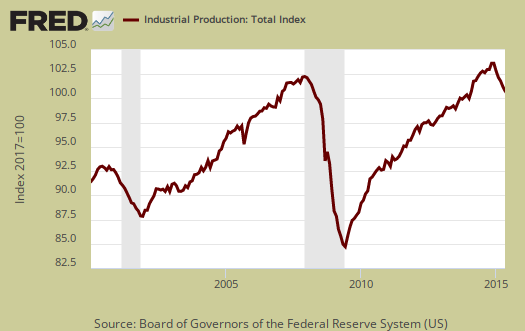
Total industrial production has now increased 1.4% from a year ago. Currently industrial production is 5.1 percentage points above the 2007 average. Below is graph of overall industrial production's percent change from a year ago.
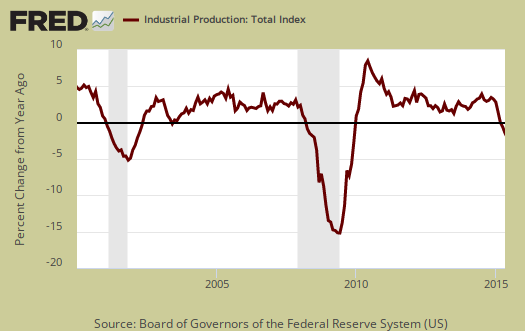
Here are the major industry groups industrial production percentage changes from a year ago.
- Manufacturing: +1.8%
- Mining: -0.3%
- Utilities: +1.3%
For the month manufacturing declined by -0.2%. Manufacturing output is 1.3 percentage points above it's 2007 Levels and is shown in the below graph.
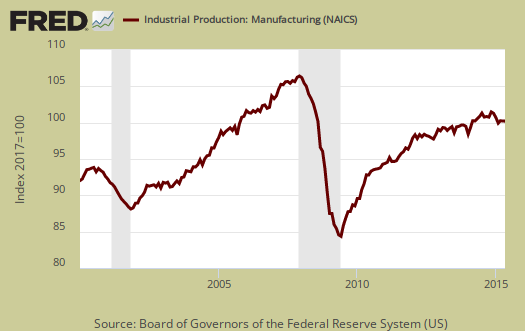
Within manufacturing, durable goods increased 0.2% for the month and 1.8% for the year. Motor vehicles & parts increased a whopping 1.7%. Machinery increased 0.4%.

Nondurable goods manufacturing was really hammered and declined by -0.7% for the month. Petroleum led the decline with a -1.6% drop but food also declined by -0.9%. Nondurable manufacturing has increased 2.3% for the year.

Mining declined -0.3% and is now down -0.3% for the year, that's quite a yearly slide. Mining includes gas and electricity production and the Fed have a special aggregate index for oil and gas well drilling. Oil and gas well drilling dropped -7.9% and for the year is down -51.2%. This is an over 50% annual decline, just an astounding collapse.
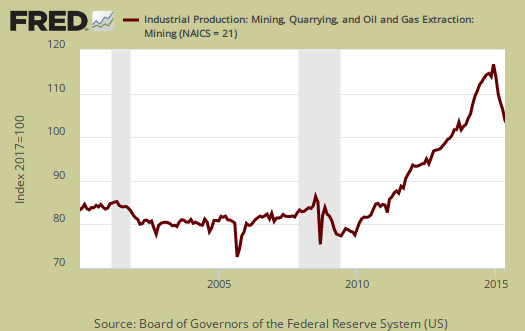
Below is oil and gas well drilling and one can see the boom and bust cycle.
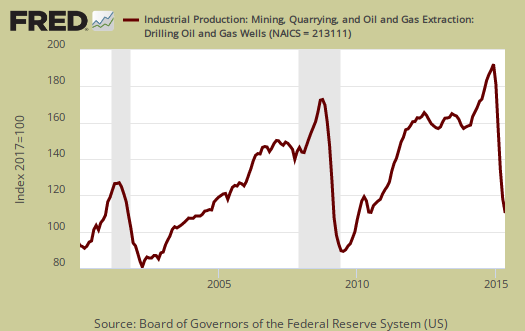
Utilities increased 0.2% for the month and are up 1.3% for the year. Utilities are volatile due to weather and why the below graph shows the wild swings.
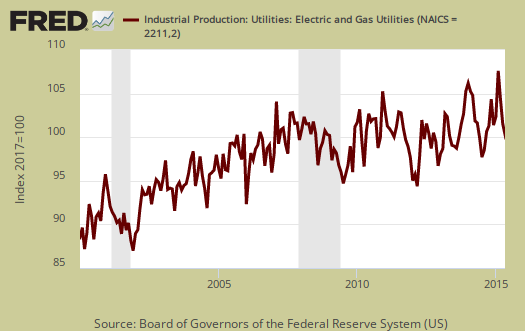
There are two reporting methodologies in the industrial production statistical release, market groups and industry groups. Market groups is output bundled together by market categories, such as business equipment or consumer goods and shown below:
Among the major market groups, only business equipment and business supplies registered production gains in May, with increases of 0.2 percent and 0.1 percent, respectively. The production of consumer goods decreased 0.3 percent, as declines for both consumer energy products and non-energy nondurables outweighed a gain for durable consumer goods. The small advance for business equipment reflected increases in transit equipment and in information processing equipment. The output of defense and space equipment fell 1.3 percent. The output of construction supplies declined 0.3 percent, which partially reversed a gain in April. The index for materials decreased 0.1 percent in May. The output of nondurable materials fell 0.7 percent and the output of energy materials edged down, but these decreases were partially offset by a small improvement in the output of durable materials.
Capacity utilization, or of raw capacity, how much is being used, for total industry is 78.1%, a decline of -0.2 percentage points from last month. . Capacity utilization has decreased a full percentage points from a year ago and is 2.0 percentage points below the long run average. This is a pretty horrific trend and cannot be blamed on just oil wells. Manufacturing capacity utilization dropped -0.2 percentage points for the month, is 77.0% and is 1.6 percentage points below it's long run average. Within manufacturing, non durable goods capacity utilization declined -1.6 percentage points for the month and is down about 1.5 percentage points below the long term average Mining capacity utilization is 83.3% and is down -0.4 percentage points for the month. Utilities use of it's capacity is 80.0% and increased 0.2 percentage points for the month.
Capacity utilization is how much can we make vs. how much are we currently using, of what capacity is available now, or output rate. Capacity utilization is also called the operating rate. Capacity utilization is industrial production divided by raw capacity.

Capacity growth is raw capacity and not to be confused what what is being utilized. Instead, this is the actual growth or potential to produce. Capacity is the overall level of plants, production facilities, and ability to make stuff, that we currently have in the United States. Capacity growth overall has increased 2.8 percentage points from a year ago and that's a decline of -0.1 percentage points from last month. Below is the capacity growth increase from a year ago of the subcategories which make up industrial production.
- Manufacturing: +2.0%
- Mining: +7.5%
- Utilities: +0.7%
Below is the Manufacturing capacity utilization graph, normalized to 2007 raw capacity levels, going back to the 1990's. One can see offshore outsourcing as the slope decreases. Pay particular attention to the 2001-2003 as manufacturing had a mass exodus to China after passage of the bad trade deal in 2000.
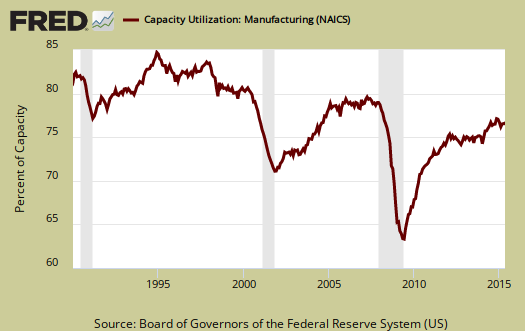
This report is actually much worse than implied. Industrial production is not adjusted for inflation and the manufacturing sector is clearly too weak. Additionally the overproduction in oil well drilling is now deflating, exposing the manufacturing weakness previously hidden. For those expecting to see a Q2 economic growth report, today's factory output doesn't support that.
Here are our previous overviews, only graphs revised. The Federal Reserve releases detailed tables for more data, metrics not mentioned in this overview.

how does this affect GDP?
is there anyway to extrapolate what's here into an impact on GDP? the upward revisions of February and March would suggest a stronger 1st quarter, but that would only make the 2nd quarter downturn in April and May that much worse in comparison..
rjs
GDP vs. IP
BEA explanation. Notice the retail trade industries are where growth is....that implies real production was offshore outsourced. Haven't seen an offshore outsourcing growth detractor estimate in a while, need to go look at that now that the BEA added intellectual property, etc. which is clearly housed outside the U.S. borders.